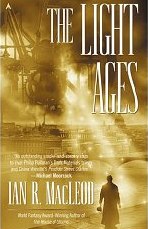The Light Ages
by Ian R. Macleod
An intriguing, lively, and strangely-prescient steampunk saga set in the Third Age of a neo-Victorian Engand that is powered by aether, a powerful and dangerous fluid extracted from vast industrial mines. Robert Borrows starts as a child in a troubled Yorkshire family. He falls in love with a little girl who inhabits a ruined mansion in a nearby, abandoned town. He travels to London, where he falls in with revolutionaries and radicals. He keeps trying to understand how the world works, and hoping to change it. Remarkably — for this was a 2005 novel — one of the great secrets of the world turns out to be the quiet replacement of mining and manufacturing with mere financial chicanery.
A fantasy about a political and economic revolution, The Light Ages invites comparison to Animal Farm. In principle, I would have expected McLeod’s novel to reflect or interpret the 1989, but the revolution here seems closer to the best of all possible 1917’s. Comparing The Light Ages to Babylon 5, another science fiction epic deeply concerned with post-Communist Eastern Europe, we see more Beautiful Principle and far less historical pain. The narrator, Robert Borrows, seems oddly deaf to himself and his world; he circles endlessly around personal concerns (his mother died of injuries suffered in an industrial accident and he’s obsessed with the victims of aether) while remaining oblivious to the girl he loves, the revolution he’s leading, or the vivid, crowded steampunk London he inhabits.
I was about to conclude that I wish The Encycloped of Science Fiction were newer or the NYRSF were online when, doing a due-diligence Google, I found that Clute himself reviewed The Light Ages for Infinite Matrix. He’s got it perfectly, if uncharitably:
The story that takes up most of the surface of The Light Ages is a tale of frustrated love told in the first person by a dolt.
